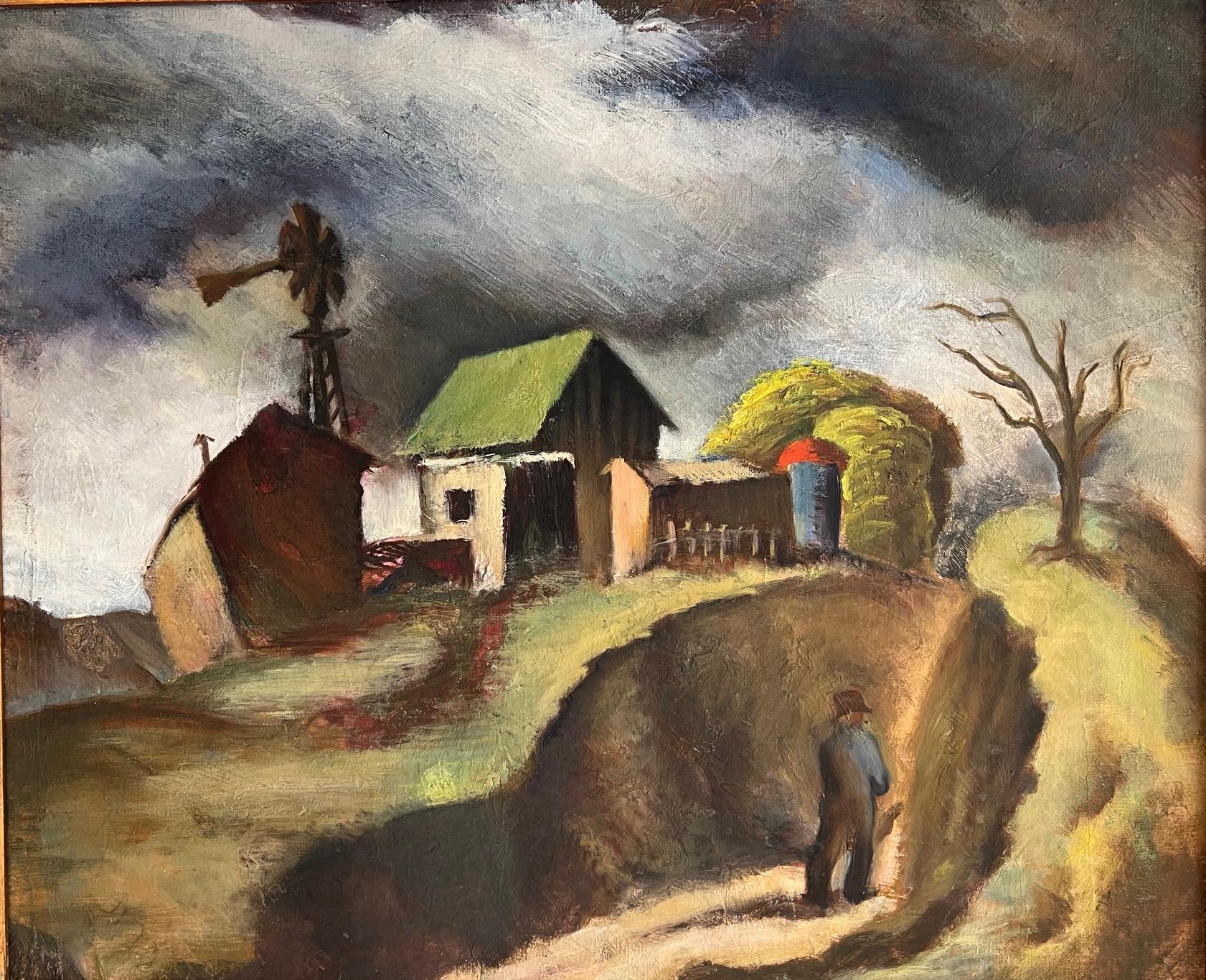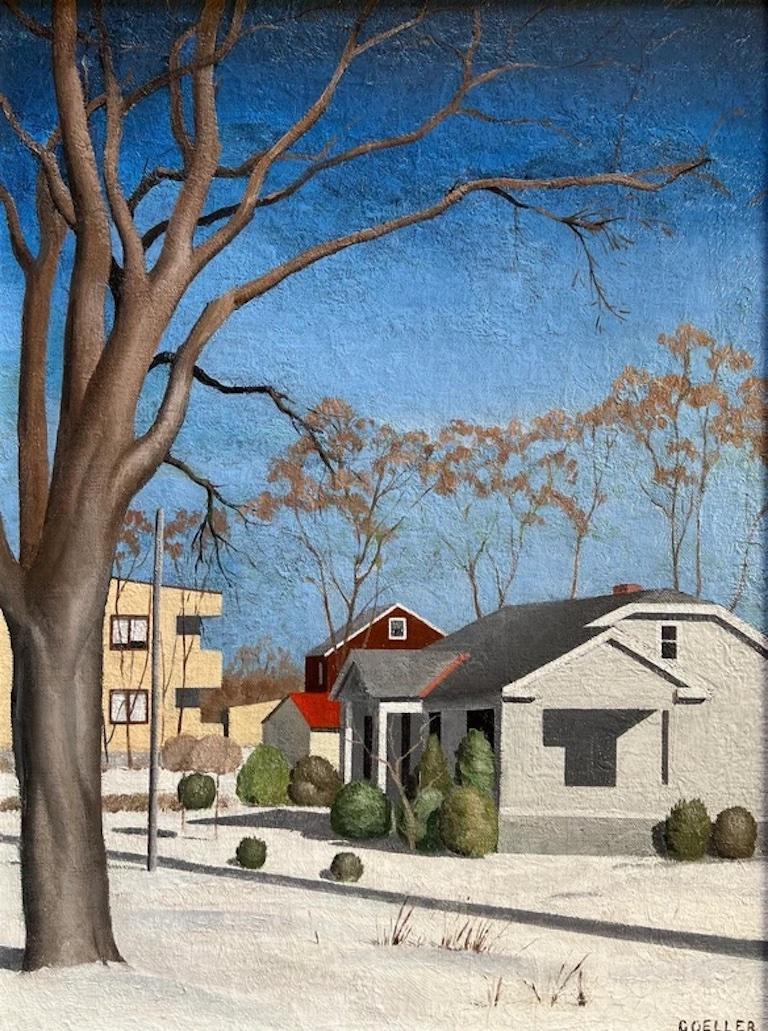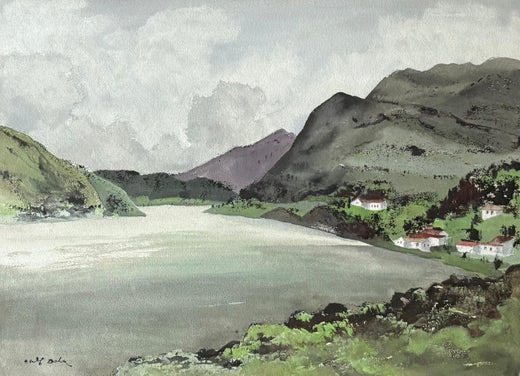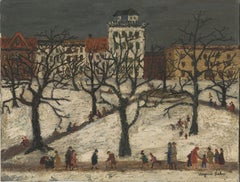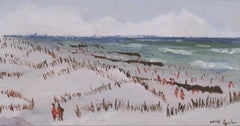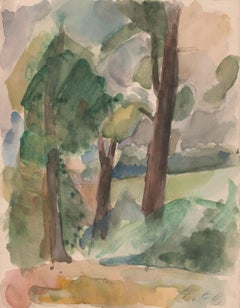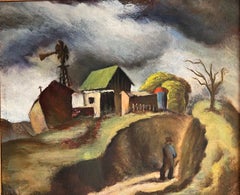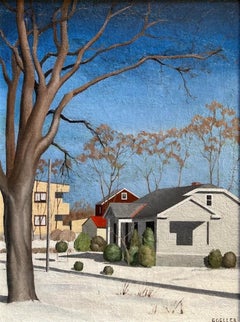Möchten Sie mehr Bilder oder Videos?
Zusätzliche Bilder oder Videos von dem*der Anbieter*in anfordern
1 von 9
Adolf Arthur DehnJersey Shore III1967
1967
Angaben zum Objekt
Jersey Shore III
Casein on Masonite, 1967
Signed lower right (see photo)
Initialed, dated and titled verso
Provenance:
Estate of the artist
Virginia Dehn (the artist's widow)
Dehn Quests
Created on location on the Jersey Shore. The Jersey Shore was the main playground for thousand to escape the summer heat of New York. This small painting shows Dehn's mastery of patterning color to depict movement and recreation. Part of a suite of paintings done on this theme. Within a year of it's creation, Dehn dies from a heart attack.
Casein on Masonite
Condition: Excellent
Image: 6 x 11"
Frame: 9 3/8 x 14 1/2"
Adolf Dehn, American Watercolorist and Printmaker, 1895-1968
Adolf Dehn was an artist who achieved extraordinary artistic heights, but in a very particular artistic sphere—not so much in oil painting as in watercolor and lithography. Long recognized as a master by serious print collectors, he is gradually gaining recognition as a notable and influential figure in the overall history of American art.
In the 19th century, with the invention of the rotary press, which made possible enormous print runs, and the development of the popular, mass-market magazines, newspaper and magazine illustration developed into an artistic realm of its own, often surprisingly divorced from the world of museums and art exhibitions, and today remains surprisingly overlooked by most art historians. Dehn in many regards was an outgrowth of this world, although in an unusual way, since as a young man he produced most of his illustrative work not for popular magazines, such as The Saturday Evening Post, but rather for radical journals, such as The Masses or The Liberator, or artistic “little magazines” such as The Dial. This background established the foundation of his outlook, and led later to his unique and distinctive contribution to American graphic art.
If there’s a distinctive quality to his work, it was his skill in introducing unusual tonal and textural effects into his work, particularly in printmaking but also in watercolor. Jackson Pollock seems to have been one of many notable artists who were influenced by his techniques.
Early Years, 1895-1922
For an artist largely remembered for scenes of Vienna and Paris, Adolf Dehn’s background was a surprising one. Born in Waterville, Minnesota, on November 22, 1895, Dehn was the descendent of farmers who had emigrated from Germany and homesteaded in the region, initially in a one-room log cabin with a dirt floor. Adolf’s father, Arthur Clark Dehn, was a hunter and trapper who took pride that he had no boss but himself, and who had little use for art. Indeed, during Adolf’s boyhood the walls of his bedroom and the space under his bed were filled with the pelts of mink, muskrats and skunks that his father had killed, skinned and stretched on drying boards. It was Adolf’s mother, Emilie Haas Dehn, a faithful member of the German Lutheran Evangelical Church, who encouraged his interest in art, which became apparent early in childhood. Both parents were ardent socialists, and supporters of Eugene Debs. In many ways Dehn’s later artistic achievement was clearly a reaction against the grinding rural poverty of his childhood.
After graduating from high school in 1914 at the age of 19—an age not unusual in farming communities at the time, where school attendance was often irregular—Dehn attended the Minneapolis School of Art from 1914 to 1917, whose character followed strongly reflected that of its director, Munich-trained Robert Kohler, an artistic conservative but a social radical. There Dehn joined a group of students who went on to nationally significant careers, including Wanda Gag (later author of best-selling children’s books); John Flanagan (a sculptor notable for his use of direct carving) Harry Gottlieb (a notable social realist and member of the Woodstock Art Colony), Elizabeth Olds (a printmaker and administrator for the WPA), Arnold Blanch (landscape, still-life and figure painter, and member of the Woodstock group), Lucille Lunquist, later Lucille Blanch (also a gifted painter and founder of the Woodstock art colony), and Johan Egilrud (who stayed in Minneapolis and became a journalist and poet).
Adolf became particularly close to Wanda Gag (1893-1946), with whom he established an intense but platonic relationship. Two years older than he, Gag was the daughter of a Bohemian artist and decorator, Anton Gag, who had died in 1908. After her husband died, Wanda’s mother, Lizzi Gag, became a helpless invalid, so Wanda was entrusted with the task of raising and financially supporting her six younger siblings. This endowed her with toughness and an independent streak, but nonetheless, when she met Dehn, Wanda was Victorian and conventional in her artistic taste and social values. Dehn was more socially radical, and introduced her to radical ideas about politics and free love, as well as to socialist publications such as The Masses and The Appeal to Reason.
Never very interested in oil painting, in Minneapolis Dehn focused on caricature and illustration--often of a humorous or politically radical character. In 1917 both Dehn and Wanda won scholarships to attend the Art Students League, and consequently, in the fall of that year both moved to New York. Dehn’s art education, however, ended in the summer of 1918, shortly after the United States entered World War I, when he was drafted to serve in the U. S. Army. Unwilling to fight, he applied for status as a conscientious objector, but was first imprisoned, then segregated in semi-imprisonment with other Pacifists, until the war ended. The abuse he suffered at this time may well explain his later withdrawal from taking political stands or making art of an overtly political nature. After his release from the army, Dehn returned to New York where he fell under the spell of the radical cartoonist Boardman Robinson and produced his first lithographs. He also finally consummated his sexual relationship with Wanda Gag.
The Years in Europe: 1922-1929
In September of 1921, however, he abruptly departed for Europe, arriving in Paris and then moving on to Vienna. There in the winter of 1922 he fell in love with a Russian dancer, Mura Zipperovitch, ending his seven-year relationship with Wanda Gag. He and Mura were married in 1926. It was also in Vienna that he produced his first notable artistic work.
Influenced by European artists such as Jules Pascin and Georg Grosz, Dehn began producing drawings of people in cafes, streets, and parks, which while mostly executed in his studio, were based on spontaneous life studies and have an expressive, sometimes almost childishly wandering quality of line. The mixture of sophistication and naiveté in these drawings was new to American audiences, as was the raciness of their subject matter, which often featured pleasure-seekers, prostitutes or scenes of sexual dalliance, presented with a strong element of caricature. Some of these drawings contain an element of social criticism, reminiscent of that found in the work of George Grosz, although Dehn’s work tended to focus on humorous commentary rather than savagely attacking his subjects or making a partisan political statement. Many Americans, including some who had originally been supporters of Dehn such as Boardman Robinson, were shocked by these European drawings, although George Grocz (who became a friend of the artist in this period) admired them, and recognized that Dehn could also bring a new vision to America subject matter. As he told Dehn: “You will do things in America which haven’t been done, which need to be done, which only you can do—as far at least as I know America.”
A key factor in Dehn’s artistic evolution at this time was his association with Scofield Thayer, the publisher of the most notable modernist art and poetry magazine of the period, The Dial. Thayer was in Vienna being analyzed by Freud, and hired Dehn to serve as his secretary and assistant, and to supervise a portfolio of reproductions of modern art—a project which gave Dehn the equivalent of an advanced graduate tutorial in the most advanced modern art being produced in Europe at that time. Among his friends at this time was the poet and painter e. e. cummings—a Harvard classmate of Thayer.
Dehn also produced lithographs, starting in 1922, working both with a virtuosos Berlin printmaker, Meister Schulz, and a Parisian master printer, Desjobert. It was in this field that he produced arguably the most influential work of his career—lithographs in which he moved away from simply drawing with a sharp crayon and introduced a variety of unusual textural effects, such as scrubbing erasing, and scraping, with a variety of tools ranging from razor blades to sandpaper, as well as the use of washes and ink wash (known as tusche) to create effects of overall tone. As Dehn himself later replained:
When I started drawing on stone, there was one traditional way of making a lithograph. It was the approach of the purist. Neatness and the smooth surface were the highest virtues. The student was cautioned, “Don’t do this, don’t do that,” The only thing one was allowed to do was to sharpen the crayon, preferably a hard one, to the finest possible point and then stroke the one for days on end until a clean little design had been developed. It is of course evident that beautiful and great prints can be made in this manner, but this delicate and careful way o drawing was stifling for some of us. It killed the creative impulse, deadened the hand.
Dehn’s innovations had very widespread influence, and ultimately reshaped the entire character of American printmaking, producing prints that had the tonal and textural richness of a painting. In June 1937, for example, in an article in The London Studio, the virtuoso lithographer Stow Wengenroth concluded a description of a group of notable lithographs with a print by Dehn which he singled out a “The most complicated of the techniques her illustrated… Precisely the order in which the various parts were done would be hard to say.”
Dehn lived principally in Vienna from 1922 to 1926, at which point his principal residence became Paris, although in this period he was rather peripatetic, and also lived for significant periods of time in Berlin and London. During the late twenties, Dehn held regular shows of his work at the Weyhe Gallery, managed by Carl Zigrosser, which did a great deal to establish his reputation as a leading American printmaker and were also modestly successful from the financial standpoint.
The Difficult Years: 1929-1936
After the financial crash of 1929, however, sales of his prints dropped significantly, and in 1933 Zigrosser declined to stage an exhibition of his most recent prints, regarding it as not worth doing from a business standpoint. For the next few years, Dehn scrambled to earn enough to survive, often spent the summer staying with his parents in Minnesota to save money on rent, and took part in a number of unprofitable business ventures, including the short-lived Adolf Dehn Print Club. For a time he even worked for the WPA at a salary of $34 a week. Around 1932-33 his marriage to Mura Zipperovitch came to an end, and for the next three summers he carried on a romance on Martha’s Vineyard with a poet named Eileen Lake. Interestingly, Jackson Pollock was also staying nearby on Martha’s Vineyard at this time, and seems to have been influenced at this time by Dehn’s innovations in printmaking, particularly his rich textural effects.
1936-1943: Watercolor and the American Scene
Around 1936, however, he began to rebuild his career. That year he travelled to Vienna, to supervise trial-proofs of reproductions of American paintings, and then spent a few weeks traveling along the Dalmatian coast and visiting Venice and Paris. On the return voyage he did something he had thought about for years but never carried through: he took up watercolor. Remarkably, up to this point in his career--he was forty-two—aside from a few pastels, he had never worked in color. From the first, he used the medium in a way which created rich textural effects, in a fashion very unusual for the period—for example, working on water-soaked paper, or creating contrasts between transparent and opaque pigment. From the first his watercolors sold readily and received enthusiastic critical acclaim. Indeed, in his book American Watercolor and Winslow Homer, the noted scholar and museum curator Lloyd Goodrich ranked Dehn as one of the half-dozen most significant American watercolorists—as a peer of such masters as Winslow Homer, Maurice Prendergast, John Marin and Edward Hopper.
In addition, in 1938 he began producing lithographs for Associated American Artists, a print-making venture established by a marketing genius, Reeves Lowenthal, who advertised his wares in national magazines and sold them in department stores. This venture also resulted in a steady stream of income. By this time, he had a new girlfriend, Elizabeth Timmerman, who was both an actress and a photographer for Life magazine. In 1940 he received a Guggenheim grant which enabled him to take a long sketching trip around the United States, and this resulted in both a sell-out exhibition at Associated American Artists, and an article of August 11, 1941 in Life magazine, which had a circulation of millions, and brought him instant fame. At this point the American Scene movement, led by figures such as Grant Wood and Thomas Hart Benton, was getting national attention. Dehn’s work fit squarely into this new artistic tendency.
An interesting outgrowth of this trip was that Dehn visited the Colorado Springs Fine Arts Center in Colorado Springs, where his former mentor, Boardman Robinson, had become head of the art school. For the next several summers he returned to Colorado Springs, to teach. An outgrowth of this activity was a major group of landscape lithographs, produced with Lawrence Barrett, who had established a lithography studio at the school, as well as his most important book illustrations, for an edition of the stories of Guy de Maupassant. He and Barrett also co-authored a textbook on lithography, How to Draw and Print Lithographs, which was published by the American Artists Group in 1950. When World War II broke out, Dehn was too old to join the army, but supported the war effort through a series of war-related projects, engineered by Reeves Lowenthal, including one documenting Navy Blimps and another celebrating the huge oil refineries at Baton Rouge.
The Late Years: 1943-1968
Dehn’s romance with Elizabeth Timmerman seems to have floundered in the early 1940s, but in 1943 he met a beautiful young woman, Virginia Engelman, twenty-three years his junior, who was working in the print department of Associated American Artists. After four years of courtship, he married her in 1947, and at that point entered into the final phase of his career—one marked by considerable financial success and domestic harmony. By this time “realist” artists such as Dehn were being pushed out of the spotlight in the New York art world by the rise of Abstract Expressionism and other radical modern styles. Nonetheless, during this period Dehn probably achieved the peak of his national fame and financial success with his prints and watercolors, many of them celebrating exotic or tropical locales such as Cuba, Haiti, the Yucatan, Italy Greece, Turkey, Iran, Afghanistan and India. About every other year he would schedule several weeks of intense works the Desjobert lithography shops in Paris, where he continued to experiment with new techniques, including his first color prints. Some of Dehn’s most popular work was produced during this period, including a watercolor titled Spring in Central Park, owned by the Metropolitan Museum of Art, which has been widely reproduced on everything from calendars and handbags—and rivals the most famous works in the collection in its popularity. During this period he continued to work at a frantic pace, although he suffered from a series of health problems, including hypertension and insomnia. The end came suddenly. On May 19, 1968, while organizing prints in his field, he suffered a massive heart attack. At the time two major projects were already in the works to celebrate his career: a book of his drawings, published by the University of Missouri Press, and a retrospective exhibition of his work organized by Mahonri Sharp Young at the Columbus Gallery of Fine Arts in Columbus, Ohio.
Dehn’s Place in the History of Art
Where does Dehn stand in the history of art? While he never did much in oil painting, in printmaking and watercolor he ranks nearly on a par with the very greatest American masters of this medium. His lithographs of the ‘twenties, with their frank depiction of nightclubs, with their performers, prostitutes, and portly patrons, introduced a new note of social satire into American printmaking; and he was one of the most gifted printmakers of the American Scene movement of the 1930s, nearly on a rank with figures such as Thomas Hart Benton and Grant Wood. Undoubtedly the most unique quality of Dehn’s work was his extraordinary exploration of new textures and techniques, which moves lithography away from mere crayon drawing into a new creative realm.
In his day, Dehn was widely regarded as one of the greatest of contemporary lithographers. Indeed, by the time of his death Dehn’s work was represented in the collections of over fifty major art museums in both Europe and the United States, including the Metropolitan Museum of Art; the Whitney Museum of American Art, the Museum of Fine Arts, Boston; The Brooklyn Museum,; the Minneapolis Institute of Fine Arts; the New York Public Library; the British Museum; the Kupferstick Kabinet in Berlin; and the Albertina in Vienna.
“Few artists have ever made the lithographic stone work as Dehn has, got so much richness out of it, so large a range of color, so tremendously sensuous an effect” wrote Guy Pene DuBois in Creative Art. “The scope of lithography seems to have been enlarged, thanks to his artist, by many leagues,” wrote Edward Alden Jewell in The New York Times.
Clinton Adams, who wrote the major book on American lithography, noted that Dehn had an extraordinary influence on his fellow artists. As Virginia Dehn recalled:
Adams told me at lunch the other day that Adolf worked with many printers that his artistic influence was very widespread. As a result of working with new litho techniques Adolf devised they were able to go ahead and suggest the techniques to other artists they worked with.
In a rather similar fashion, his watercolors rank with the best produced in American art of their period, and are also notable for their lively range of subject matter and highly creative use of new techniques.
For Dehn himself, art was primarily a way of connecting with life. Virginia Dehn recalled:
“He never made statements about his greatest contributions as an artist. He was essentially a modest man. Nor did he ever to my knowledge say that that he was a stronger technician than anyone else. He did have, I think, a quite belief in his achievements in lithography and watercolor.”
When asked late in life to produce a statement for a show of his work at St. Olaf College, in Northfield, Minnesota, Dehn chose to produce a sort of anti-statement—a plea that art is something that shouldn’t be reduced to an explanation. Along the way he slipped in a few digs at the abstract crowd, who he felt had reduced art to something to puzzle over rather than to enjoy. As he wrote:
You ask for a statement concerning my work. So my statement is a statement against making a statement. My paintings are my statement. What I have to offer as a painter is direct and simple and words are not necessary to a greater understanding or enjoyment of them. If anyone does not understand then words will not help him. I cannot imagine El Greco or Rembrandt or Renoir being asked for a statement every time they showed a painting, or if they were asked troubling to write one. Let us leave such statement, which are often grandiloquent, high sounding and ambiguous to the avant-garde boys who make them. Their paintings bewilder the dear pubic whom we all want to educate and their statements only add to the befuddlement.
Surely Dehn’s central goal was not to change the history of art, but to provide a sort of living record of the life he lived, and to give delight to the viewer. He once declared that “the very act of drawing made me participate in the life around me,” and as he once wrote:
“My attitude to life is rather sensuous—and sensual too—and only after I have filled myself with sensuous experiences can I go about working. Putting it simply: when I am fed up, I work. I am crazy about life and want to have as much out of it as I can. Take away my work and I lose interest in life, yet the work comes after my living life, or rather out of it.”
Looking at his work--even at the satires which have an element of the gothic and morbid
-- it is hard not to feel delight both in the work itself and in one’s sense of a life well lived.
- Schöpfer*in:Adolf Arthur Dehn (1895-1968, Amerikanisch)
- Entstehungsjahr:1967
- Maße:Höhe: 15,24 cm (6 in)Breite: 27,94 cm (11 in)
- Medium:
- Bewegung und Stil:
- Zeitalter:
- Zustand:
- Galeriestandort:Fairlawn, OH
- Referenznummer:Anbieter*in: AD124551stDibs: LU14016413312
Adolf Arthur Dehn
Adolf Dehn, Grafiker, Aquarellist und Illustrator, wurde 1895 in Waterville, Minnesota, geboren. 1914 begann er ein Studium an der Minneapolis School of Art, und 1917, dem Jahr, in dem seine erste veröffentlichte Zeichnung in der progressiven Zeitschrift The Masses erschien, erhielt er ein Stipendium für ein Studium an der Art Students League in New York. Dort arbeitete er mit Kenneth Hayes Miller zusammen und wurde von Boardman Robinson in die Lithografie eingeführt. Während seines Aufenthalts in New York engagierte sich Dehn in der liberalen Politik. Als er sich 1918 aus Gewissensgründen zum Kriegsdienstverweigerer erklärte, musste er vier Monate in einem Bootcamp in Spartanburg, South Carolina, verbringen, weil er sich weigerte, in den Streitkräften zu dienen, und acht Monate als freiwilliger Ausbilder Mal- und Zeichenunterricht in einem Krankenhaus für Kriegsopfer in Asheville, North Carolina, geben. Die Jahre 1920 bis 1929 verbrachte Dehn mit Kunstreisen in Europa, vor allem in Wien und in Paris, wo er im Atelier Desjobert Lithografien anfertigte. Während dieser Zeit stellte Dehn seine Werke in der Weyhe Gallery in New York aus und lieferte Zeichnungen an Zeitschriften im Ausland und an die radikale Zeitschrift The Masses. Nach seiner Rückkehr nach New York im Jahr 1929 wurde er zu einer führenden Persönlichkeit in den Kreisen der Druckgrafik und stellte seine Drucke unter großem Beifall der Kritiker aus. Bis 1937 hatte Dehn ausschließlich in Schwarz-Weiß gearbeitet, bis er nach der Hälfte seiner Karriere begann, Aquarelle zu malen. Während seiner Sommeraufenthalte in Minnesota schuf er eine große Anzahl regionaler Aquarelle, die die Seen und Farmen seines Heimatstaates zeigen. Lithografie und Aquarell bleiben seine beiden wichtigsten Medien, und seine Themen reichen von Gesellschaftssatire bis zu naturalistischen Landschaften. Er verfasste 1945 die Abhandlung Aquarellmalerei und 1950 und 1955 zwei weitere Lehrbücher über Lithografie und Aquarellmalerei. Von 1938 bis 1939 unterrichtete er am Stephens College in Columbia, Missouri, und während der Sommer 1940-1942 lehrte er am Colorado Springs Fine Arts Center. In den Jahren 1939 und 1951 erhielt Dehn ein Guggenheim-Stipendium, und 1961 wurde er zum ordentlichen Mitglied der National Academy of Design gewählt. Dehn stellte während seiner gesamten Karriere aus, und seine Werke befinden sich unter anderem in den ständigen Sammlungen des Metropolitan Museum of Art, des Museum of Modern Art, des Art Institute of Chicago, des Museum of Fine Arts in Boston und des British Museum. Adolf Dehn starb 1968 in New York.
Anbieterinformationen
5,0
Anerkannte Anbieter*innen
Diese renommierten Anbieter*innen sind führend in der Branche und repräsentieren die höchste Klasse in Sachen Qualität und Design.
Gold-Anbieter*in
Premium-Anbieter*innen mit einer Bewertung über 4,3 und 24 Stunden Reaktionszeit
Gründungsjahr 1978
1stDibs-Anbieter*in seit 2013
789 Verkäufe auf 1stDibs
Typische Antwortzeit: <1 Stunde
Verbände
International Fine Print Dealers Association
- VersandAngebot wird abgerufen …Versand von: Fairlawn, OH
- Rückgabebedingungen
Einige Inhalte dieser Seite wurden automatisch übersetzt. Daher kann 1stDibs nicht die Richtigkeit der Übersetzungen garantieren. Englisch ist die Standardsprache dieser Website.
Authentizitätsgarantie
Im unwahrscheinlichen Fall eines Problems mit der Echtheit eines Objekts kontaktieren Sie uns bitte innerhalb von 1 Jahr für eine volle Rückerstattung. DetailsGeld-Zurück-Garantie
Wenn Ihr Objekt nicht der Beschreibung entspricht, beim Transport beschädigt wurde oder nicht ankommt, kontaktieren Sie uns bitte innerhalb von 7 Tagen für eine vollständige Rückerstattung. DetailsStornierung innerhalb von 24 Stunden
Sie können Ihren Kauf jederzeit innerhalb von 24 Stunden stornieren, ohne jegliche Gründe dafür angeben zu müssen.Geprüfte Anbieter*innen
Unsere Anbieter*innen unterliegen strengen Dienstleistungs- und Qualitätsstandards, wodurch wir die Seriosität unserer Angebote gewährleisten können.Preisgarantie
Wenn Sie feststellen, dass ein*e Anbieter*in dasselbe Objekt anderswo zu einem niedrigeren Preis anbietet, werden wir den Preis entsprechend anpassen.Zuverlässige weltweite Lieferung
Unsere erstklassigen Versandunternehmen bieten spezielle Versandoptionen weltweit, einschließlich individueller Lieferung.Mehr von diesem*dieser Anbieter*in
Alle anzeigenPark-Szene (Chelsea, Manhattan)
Von Virginia Dehn
Park-Szene (Chelsea, Manhattan)
Öl auf Karton des Künstlers, ca. 1947-49
Signiert unten rechts (siehe Foto)
Provenienz: Nachlass des Künstlers
Dehn Erben
Zust...
Kategorie
1940er, Amerikanische Moderne, Landschaftsgemälde
Materialien
Öl
Jersey-Schuh III
Von Adolf Arthur Dehn
Jersey-Schuh III
Kasein auf Masonit, 1967
Signiert unten rechts (siehe Foto)
Verso paraphiert, datiert und betitelt
Provenienz:
Nachlass des Künstlers
Virginia Dehn (die Witwe des Kü...
Kategorie
1960er, Amerikanische Moderne, Landschaftsgemälde
Materialien
Öl
Ossabaw (Georgia) Bucht
Von Virginia Dehn
Ossabaw-Bucht
Acryl auf Papier
Signiert mit Tinte unten rechts
Ossabaw Sound Inlet in Ossbaw Island Georgia, am Atlantischen Ozean in der Nähe von Hinesville GA gelegen
"Während ihre...
Kategorie
1990er, Amerikanische Moderne, Landschaftsgemälde
Materialien
Acryl
Landschaft mit Bäumen
Von Leon Kelly
Landschaft mit Bäumen
Aquarell auf Papier, 1929
Signiert mit Bleistift in der rechten unteren Ecke
Offensichtlich beeinflusst von den Cezanne-Werken aus der Sammlung seines Mäzens Al...
Kategorie
1920er, Amerikanische Moderne, Landschaftsgemälde
Materialien
Wasserfarbe
Arctic Light - Orange Sonne
Von Karl Zerbe
Arktisches Licht-Orange Sonne
Vorzeichenlos
Gouache auf japanischem Faserpapier
Serie: Tundra-Gemälde
Ausgestellt: Karl Zerbe, Gouachen aus der Arktis
Nordness Gal...
Kategorie
1950er, Amerikanische Moderne, Abstrakte Gemälde
Materialien
Gouache
Gaspflanzhäuser
Von William C. Grauer
Titel Unbekannt (Gaspe Bay Houses)
Acryl auf Karton, 46 1/4 x 34 Zoll
Signiert unten rechts
Zustand: Gut
Geringfügige Abnutzung der Oberfläche des Rahmens
Provenien...
Kategorie
1970er, Amerikanische Moderne, Landschaftsgemälde
Materialien
Acryl
Das könnte Ihnen auch gefallen
The Ledge
Von Georgina Klitgaard
Georgina Klitgaard (1893 - 1976) The Ledge, um 1931, Öl auf Leinwand, rechts unten signiert, 32 1/8 x 50 1/8 Zoll, ausgestellt: 1) 44th Annual Exhibition of American Paintings & Scu...
Kategorie
1930er, Amerikanische Moderne, Landschaftsgemälde
Materialien
Leinwand, Öl
Landschaft
Von Marcel Emile Cailliet
Landschaft, 1940, Öl auf Leinwand, 24 x 20 Zoll, signiert, datiert und betitelt verso: "Marcel Cailliet '40 - S.C." und "Marcel Cailliet Landscape"; wahrscheinlich ausgestellt auf de...
Kategorie
1940er, Amerikanische Moderne, Gemälde
Materialien
Leinwand, Öl
Sommer in der Stadt
Summer in Town, 1943, Öl auf Karton, signiert und datiert unten rechts, 13 ¾ x 22 Zoll, verso betitelt und datiert, ausgestellt: 1) 139. Jahresausstellung, Pennsylvania Academy of Fi...
Kategorie
1940er, Amerikanische Moderne, Landschaftsgemälde
Materialien
Öl, Karton
Suburb (im Winter)
Dieses Gemälde ist Teil unserer Ausstellung Charles Goeller: Eine wehmütige Einsamkeit.
Öl auf Leinwand, 20 x 15 Zoll, rechts unten signiert
Ausgestellt:
1) Porträt von Amerika: Art...
Kategorie
1940er, Amerikanische Moderne, Landschaftsgemälde
Materialien
Öl
Peck Slip
Peck Slip, 1950, Öl auf Karton, 15 x 20 Zoll, Ausstellungsetikett auf der Rückseite: "Öl auf Karton, 20 x 15, 1950 / Titel: Peck Slip / Preis: $100 / Künstler und Besitzer: Fiske Boy...
Kategorie
1950er, Amerikanische Moderne, Landschaftsgemälde
Materialien
Öl, Karton
3.500 $
Johnny Walker's Platz
Von Georgina Klitgaard
Johnny Walker's Place, um 1929, Öl auf Leinwand, rechts unten signiert, 34 x 42 Zoll, ausgestellt 1) 28. Internationale Ausstellung für Malerei, Carnegie Institute, Pittsburgh, PA, 1...
Kategorie
1920er, Amerikanische Moderne, Landschaftsgemälde
Materialien
Leinwand, Öl
